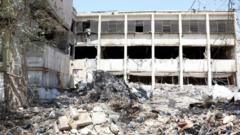As deliberations continue, President Trump maintains a cautious stance on military action against Iranian nuclear facilities.
US Airstrike on Iran: A Calculated Risk with Uncertain Consequences

US Airstrike on Iran: A Calculated Risk with Uncertain Consequences
Experts warn that potential repercussions of a strike on Iran could mirror past military interventions.
June 18, 2025 — Following heightened discussions regarding a potential strike on Iran’s heavily fortified nuclear facility, the U.S. government's considerations are tinged with hesitance, echoing sentiments reflected during previous military engagements. The operations would involve the sophisticated B-2 stealth bomber, known for its precision and capability to deliver powerful 30,000-pound bunker-buster bombs. Targeting the Fordo site, entrenched deep within mountainous regions, poses significant risks associated with unintended consequences.
Historically, the implications of a military strike extend beyond immediate tactical results, as seen in the U.S. incursions into Iraq and Afghanistan. Cautionary advice surfaces again as military analysts voice concerns over the unpredictable outcomes of such engagements. The potential repercussions not only involve Iran’s responses but also ripple effects throughout the geopolitical landscape, potentially drawing in allies and adversaries alike.
President Trump's recent statements reflect an ongoing internal debate within the administration. While previously adopting a more aggressive rhetoric, Trump tempered his comments on potential military action, stating, “I may do it. I may not do it.” This shift indicates a move towards contemplating the broader ramifications of any military decision, drawing from lessons learned in past U.S. military interventions.
As the administration weighs its options, one thing remains clear: the course of action concerning Iran's nuclear ambitions entails a meticulous balancing act between military capabilities and diplomatic strategies, emphasizing the need for a thorough evaluation of both present and future consequences.
Historically, the implications of a military strike extend beyond immediate tactical results, as seen in the U.S. incursions into Iraq and Afghanistan. Cautionary advice surfaces again as military analysts voice concerns over the unpredictable outcomes of such engagements. The potential repercussions not only involve Iran’s responses but also ripple effects throughout the geopolitical landscape, potentially drawing in allies and adversaries alike.
President Trump's recent statements reflect an ongoing internal debate within the administration. While previously adopting a more aggressive rhetoric, Trump tempered his comments on potential military action, stating, “I may do it. I may not do it.” This shift indicates a move towards contemplating the broader ramifications of any military decision, drawing from lessons learned in past U.S. military interventions.
As the administration weighs its options, one thing remains clear: the course of action concerning Iran's nuclear ambitions entails a meticulous balancing act between military capabilities and diplomatic strategies, emphasizing the need for a thorough evaluation of both present and future consequences.





















